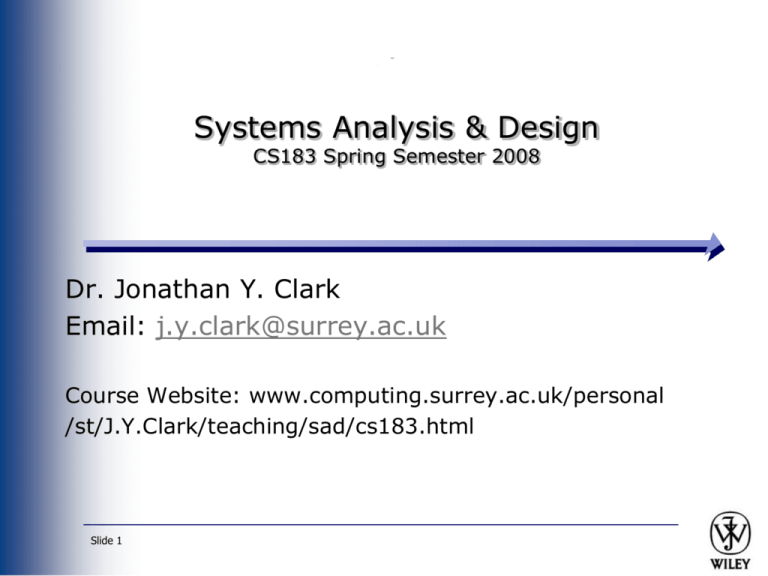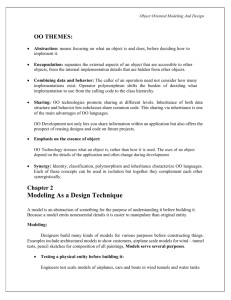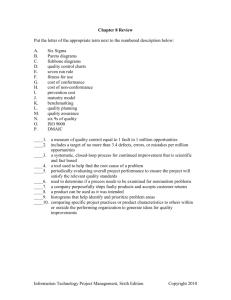
Systems Analysis & Design
CS183 Spring Semester 2008
Dr. Jonathan Y. Clark
Email: j.y.clark@surrey.ac.uk
Course Website: www.computing.surrey.ac.uk/personal
/st/J.Y.Clark/teaching/sad/cs183.html
Slide 1
Course Textbook:
Systems Analysis and Design With UML 2.0
An Object-Oriented Approach, Second Edition
Chapter 2:
Introduction to Object-Oriented Systems
Analysis & Design with the Unified Modeling
Language
Slide 2
Adapted from slides © 2005
John Wiley & Sons, Inc.
Slide 3
Objectives
Understand the basic characteristics
of object-oriented systems.
Be familiar with the Unified
Modeling Language (UML),V.2.0.
Slide 4
Non-Object-Oriented…
Process models
Based on behaviour and actions
Data Models
Based on static (fixed)
representations of data
Slide 5
A “Simple” Process for Making Lunch
Slide 6
Process Modelling:
Data Flow Diagrams
Slide 7
Reading a DFD
Slide 8
Data Modelling:
Entity-Relationship
Diagrams (ERDs)
Slide 9
What Is an ERD?
A picture showing the
information created, stored, and
used by a business system.
Entities generally represent
people, places, and things of
interest to the organization.
Lines between entities show
relationships between entities.
Slide 10
An ERD Example
PowerPoint Presentation for Dennis, Wixom & Tegardem
Systems Analysis and Design
Copyright 2001 © John Wiley & Sons, Inc. All rights reserved.
Entities and Instances
Slide 12
Object-Oriented Approaches
Combine processes and data
Are more ‘natural’
Slide 13
Basic Characteristics of
Object Oriented Systems
Classes and Objects
Methods and Messages
Encapsulation and Information
Hiding
Inheritance
Polymorphism
Slide 14
Helpful Hint….’Compile’
C Classes
O Objects
M Methods and Messages
P Polymorphism
I Inheritance
(Last, but not least)
E Encapsulation
Slide 15
Classes and Objects
Class – Template to define
specific instances or objects
Object – Instantiation of a class
Attributes – Describes the
object
Behaviours – specify what
object can do
Slide 16
Classes and Objects
Slide 17
Methods and Messages
Methods implement an object’s
behaviour
Analogous to a function or
procedure
Messages are sent to trigger
methods
Procedure call from one object to
the next
Slide 18
Messages and Methods
Slide 19
Encapsulation and
Information Hiding
Encapsulation
combination of data and process into
an entity
Information Hiding
Only the information required to use a
software module is published to the
user
Reusability is the Key Point
an object is used by calling methods
Slide 20
Inheritance
Superclasses or general classes
are at the top of a hierarchy of
classes
Subclasses or specific classes
are at the bottom
Subclasses inherit attributes
and methods from classes
higher in the hierarchy
Slide 21
Class Hierarchy
Slide 22
Inheritance
Slide 23
Polymorphism
A message can be interpreted
differently by different classes of
objects
e.g. A ‘Create_Record’ message is
essentially the same thing, but
causes ‘Create_Patient_Record’ by a
‘Patient_Database’ object, or
‘Create_Doctor_Record’ by a
‘Healthcare_Staff_Database’ object
Slide 24
Polymorphism & Encapsulation
Slide 25
Benefits of the Object Approach
Slide 26
The Unified Modelling
Language, Version 2.0
Functional Diagrams
Structure Diagrams
Behaviour Diagrams
Developers
Grady Booch
Ivar Jacobson
James Rumbaugh
Slide 27
Functional Diagrams
Activity Diagrams
Illustrate business workflows
Use-Case Diagrams
Capture business requirements
Illustrates interaction between
system and environment
Slide 28
Structure Diagrams
Class diagrams
relationship between classes
Object diagrams
Relationships between objects
Slide 29
Behaviour Diagrams
Interaction Diagrams ....
Sequence diagrams
Show Time-based ordering and behaviour
of objects and their activities
State Machines ...
Behavioural State Machines
(Statechart diagrams)
Slide 30
Examines behaviour of one class/object
Object Oriented Systems
Analysis and Design
•
•
•
Use-case driven
Iterative and Incremental
Often associated with PHASED
Development (a RAD
methodology)
Slide 31
Basic Method for Development of
Object Oriented Systems
Identifying business value
Analyze feasibility
Develop workplan
Staff the project
Control and direct project
Requirements determination
Functional modelling
Structural modelling
Behavioural modelling
Moving on to design
Slide 32
Summary
Process oriented (Data flow
diagrams) and Data oriented (Entity
relationship diagrams)
Basic characteristics of Object
Oriented Systems Analysis and
Design
Introduction to Unified Modelling
Language and the Unified Process
Slide 33








